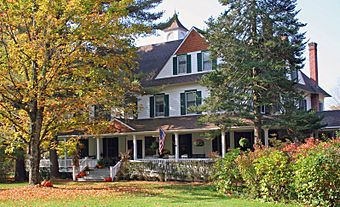Beaverkill Valley Inn facts for kids
Quick facts for kids |
|
|
Beaverkill Valley Inn
|
|

East elevation and north profile, 2007
|
|
| Location | Lew Beach, NY |
|---|---|
| Nearest city | Kingston |
| Area | 60.7 acres (24.6 ha) |
| Built | 1895 |
| NRHP reference No. | 85002280 |
| Added to NRHP | September 12, 1985 |
The Beaverkill Valley Inn, which used to be called The Bonnie View, is a large wooden hotel located near Lew Beach, New York. It was built in 1895, over 125 years ago. This special inn was created for people who loved to fish for trout in the nearby Beaver Kill river.
It is one of the few old fishing lodges still standing in the Catskill Mountains. It's also the only one left along the upper part of the Beaver Kill river. Because of its history, the inn was added to the National Register of Historic Places in 1985. This means it's recognized as an important historical building.
Contents
What the Inn Looks Like
The inn is built on a big piece of land, about 60 acres, right next to the Beaver Kill river. The main building is a two-story structure shaped like an "L." It has a roof with pointed ends, called gables. You can also see large windows sticking out from the roof, known as dormers.
At the very top of the inn, there's a small, decorative tower called a cupola. The outside walls are covered with long, thin wooden boards called clapboard.
The Porch and Entrances
A wide porch, or veranda, wraps around the front and sides of the inn. It's supported by square pillars. You can walk onto the porch from different stairways. There's even a special covered entrance for cars, called a porte-cochère, on the north side. All the windows have decorative wooden shutters next to them.
Inside the Inn
When you go inside, you'll find a main hallway. On either side are sitting rooms and a dining room. These rooms still have their original wooden trim and cozy fireplaces made of brick and stone. The stairs also have their original carved wooden railings.
Upstairs, the rooms on the second floor have been made larger. This allowed for private bathrooms to be added. The rooms on the third floor are still their original size, but their shared bathrooms have been made bigger. Downstairs, the basement has been finished and is used as a laundry area and a game room.
Other Buildings and Fun Things to Do
Near the main inn, there are two old barns that have been updated. They are now used as conference rooms and support a swimming pool. Up the hill, hidden by trees, are the inn's tennis courts. There's also a new building called a springhouse that replaced an older one. The property has many hiking trails and footpaths for guests to explore and enjoy nature.
A Look Back in Time
For a long time, the upper Beaverkill Valley was mostly empty. This was because it was hard to farm there and it was far away from cities. But the streams were full of trout. Early settlers, like loggers and trappers, would catch them for food.
Fishing Becomes Popular
Around 1819, a famous writer named Washington Irving wrote about how many trout were in these streams. This was when fishing for fun, called angling, was just starting to become popular in the United States. Later, in 1838, a magazine called The American Turf Register and Sporting Magazine said the Beaver Kill was one of the best trout streams in the country.
When railroads like the Erie Railroad came to the Catskills, it became much easier for people from the city to visit. Many anglers started coming to fish. As other industries like tanning declined, tourism, especially from fishermen, became very important to the area.
The Golden Age of Fly Fishing
In the late 1800s, a special way of fishing called dry-fly trout fishing became popular here. A local resident named Theodore Gordon was a pioneer in this method. He is often called the "father of American dry-fly fishing."
From 1895 to 1915, many new fishing techniques and tools were developed. People learned how to tie their own fishing flies, and new types of fishing rods were made. A community of anglers grew around the Beaverkill and other Catskill rivers. They even formed private clubs to protect their favorite fishing spots. They helped keep the rivers healthy and even stopped plans to build dams on them.
The Inn's Role in History
During this "golden age" of Catskill fly fishing, many hotels were built for sport fishermen. Three of these old hotels are still around today: Antrim Lodge, the Central House, and the Beaverkill Valley Inn.
The Beaverkill Valley Inn was first opened in 1895 as "The Bonnie View." It was built specifically as a hotel for fishermen. Its design, with its large porch and fireplaces, was typical of the late Victorian style. It offered comforts that wealthy city guests would have liked.
In the early 1980s, new owners updated the inn and added more fun activities. They also changed its name to the Beaverkill Valley Inn. Out of 18 hotels and guesthouses that once hosted fishermen along the upper Beaverkill, the Beaverkill Valley Inn is the only one still open and operating today.

